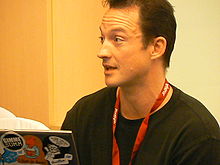
Lucasfilm Games is an American video game licensor and a subsidiary of Lucasfilm. It was founded in May 1982 by George Lucas as a video game development group alongside his film company; as part of a larger 1990 reorganization of the Lucasfilm divisions, the video game development division was grouped and rebranded as part of LucasArts. LucasArts became known for its line of adventure games based on its SCUMM engine in the 1990s, including Maniac Mansion, the Monkey Island series, and several Indiana Jones titles. A number of influential game developers were alumni of LucasArts from this period, including Brian Moriarty, Tim Schafer, Ron Gilbert, and Dave Grossman. Later, as Lucasfilm regained control over its licensing over the Star Wars franchise, LucasArts produced numerous action-based Star Wars titles in the late 1990s and early 2000s, while dropping adventure game development due to waning interest in the genre.
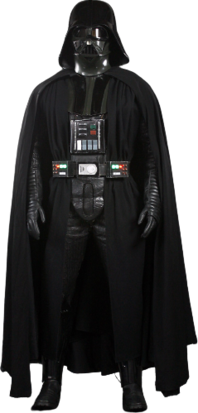
Darth Vader is a character in the Star Wars franchise. He is the primary antagonist of the original film trilogy and, as Anakin Skywalker, is the protagonist of the prequel trilogy. Born a slave on the planet Tatooine, he becomes a powerful Jedi. He is lured to the dark side of the Force by Chancellor Palpatine, and becomes the Sith Lord Darth Vader. After being severely wounded in a lightsaber battle, he is transformed into a cyborg. He is the husband of Padmé Amidala and the biological father of Luke Skywalker and Leia Organa Solo.

Star Wars: Knights of the Old Republic is a role-playing video game developed by BioWare and published by LucasArts. The first installment of the Star Wars: Knights of the Old Republic series, it was released for the Xbox on July 16, 2003, and for Microsoft Windows on November 19, 2003. It was ported to Mac OS X, iOS, and Android by Aspyr, and it is playable on the Xbox 360, Xbox One, and Xbox Series X and Series S via backward compatibility. A Nintendo Switch version was released on November 11, 2021.
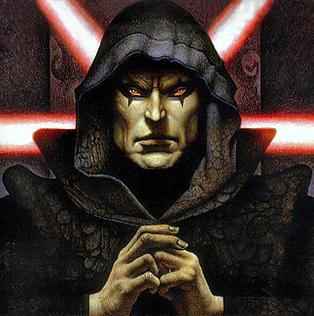
Darth Bane is a fictional character created by George Lucas in the Star Wars franchise. In the Star Wars universe, Darth Bane is a powerful Sith Lord who lived one thousand years before the events of the films and is known for being the originator of the Sith's "Rule of Two", which states: "One master and one apprentice can be the only Sith in the galaxy at a time". Before it the Sith empire was structured like the Jedi but due to their shortfalls he killed them and created this new rule.
Obsidian Entertainment, Inc. is an American video game developer based in Irvine, California. It was founded in June 2003, shortly before the closure of Black Isle Studios, by ex-Black Isle employees Feargus Urquhart, Chris Avellone, Chris Parker, Darren Monahan, and Chris Jones.
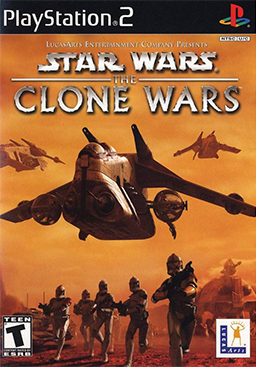
Star Wars: The Clone Wars is a video game set in the Star Wars universe developed by Pandemic Studios and published by LucasArts for GameCube, PlayStation 2 and Xbox. It consists mostly of vehicular combat using clone warships, starfighters, speeder bikes and tanks, as well as missions where players can control Anakin Skywalker, Obi-Wan Kenobi, or Mace Windu on foot. The game is set in the Star Wars prequel trilogy era, with the first level encompassing the Battle for Geonosis from Episode II: Attack of the Clones. The game also features multiplayer modes for up to four players in splitscreen, or online via Xbox Live for the Xbox. It holds aggregate scores of 73 out of 100, 72 out of 100 and 71 out of 100 on review aggregator Metacritic for the GameCube, PlayStation 2, and Xbox, respectively.
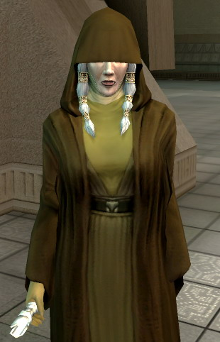
Kreia is a character and party member in Obsidian Entertainment's Star Wars Knights of the Old Republic II: The Sith Lords. She is a blind Force-sensitive who forms a "bond" with the player character, the Jedi Exile, through the Force. Kreia sets herself up as the Exile's mentor, and rejects the divide of the light and dark side of the Force, as well as the predestination the Force entails. By the game's end, it is revealed she is the Sith Lord Darth Traya and is planning on destroying the Force, and she becomes the final boss of The Sith Lords. Kreia makes no more appearances in Star Wars fiction, though a miniature by Wizards of the Coast was released in August 2008, and she appears as an obtainable character in Star Wars: Galaxy of Heroes.

Aspyr Media, Inc. is an American video game developer and publisher founded by Michael Rogers and Ted Staloch in Austin, Texas. Originally founded to bring top gaming titles to macOS, the company, since 2005, has become a publisher and developer of entertainment for multiple gaming platforms.

Over one hundred video games based on the Star Wars franchise have been released, dating back to some of the earliest home consoles. Some are based directly on films while others rely heavily on the Star Wars Expanded Universe.

Star Wars: Episode III – Revenge of the Sith is an action video game based on the movie of the same name. It was released on May 5, 2005, for the PlayStation 2, Xbox, Game Boy Advance, Nintendo DS, and Symbian OS. For the Xbox 360's backwards compatible lineup, Revenge of the Sith is one out of the 400+ backwards compatible games for the 360. As part of the PlayStation 2 classics program, the PlayStation 2 version was re-released in Europe on the PlayStation Network on February 11, 2015, and in North America on April 28, 2015. Meanwhile, the Xbox version was also added to the backwards compatibility list for the Xbox One and Xbox Series X/S on November 15, 2021.

The video games Star Wars: Knights of the Old Republic (2003) and Star Wars Knights of the Old Republic II: The Sith Lords (2004) features a large cast of characters noted for its diversity and is the subject of significant discussion from gaming magazines and websites.
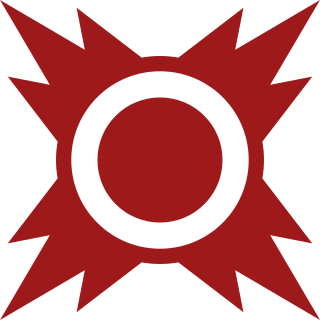
The Sith are the main antagonists of many works in the fictional universe of the Star Wars franchise. They are the antithesis and ancient enemies of the Jedi. The Sith Order is depicted as an ancient cult of warriors who draw strength from the dark side of the Force and use it to seize power by any means necessary, including terrorism and mass murder; their ultimate goals are to destroy the Jedi and rule the galaxy. The various antagonistic factions in the franchise, namely the Confederacy of Independent Systems, the First Galactic Empire, the Imperial Remnant and the First Order all originated, with the Sith. Sith, known individually as Sith Lords, are, by nature, ruthless. At any point a single individual assumes absolute authority amongst their kind and is granted the honorific Dark Lord of the Sith. Sith culture is based on perpetual treachery and betrayal. The fate of Sith Lords is, typically, to be murdered and replaced by their own apprentices. Sith teach their apprentices to revere the dark side of the Force, to give full reign to aggressive emotions such as rage and hatred, and to believe that others are expendable in the pursuit of power, it makes the Lords' demise inevitable.

Star Wars: Knights of the Old Republic (KOTOR) is a media franchise of space western role-playing video games created and developed by BioWare, which have seen releases on the original Xbox, Xbox 360, Microsoft Windows, OS X, Xbox One, Xbox Series X/S, IOS and Android. The franchise takes place in the fictional universe of Star Wars by George Lucas.
Star Wars: Jedi Knight is a series of first- and third-person shooter video games set in the fictional Star Wars expanded universe. The series focuses primarily on Kyle Katarn, a former Imperial officer who becomes a mercenary working for the Rebel Alliance, and later a Jedi and instructor at Luke Skywalker's Jedi Academy. While the first game is set a year after the events of A New Hope, the sequels take place in the decade following Return of the Jedi.

Star Wars: The Old Republic is a massively multiplayer online role-playing game (MMORPG) based in the Star Wars universe. Developed by BioWare Austin and a supplemental team at BioWare Edmonton, the game was announced on October 21, 2008. The video game was released for the Microsoft Windows platform on December 20, 2011 in North America and part of Europe. It was released in Oceania and Asia on March 1, 2012.

Star Wars Jedi Knight: Mysteries of the Sith is an expansion pack for the 1997 first-person shooter Star Wars Jedi Knight: Dark Forces II, developed and published by LucasArts for Microsoft Windows in 1998. It was re-released on Steam in September 2009. The expansion includes a new single-player story mode and fifteen multiplayer maps. The single-player story, set in the fictional Star Wars expanded universe five years after the events of Dark Forces II, follows both returning protagonist Kyle Katarn, a Jedi Master and mercenary working for the New Republic, and Mara Jade, a character featured in numerous Star Wars expanded universe works, who is being trained by Katarn in the Jedi arts. After Katarn goes missing while investigating an ancient Sith temple, Jade continues her studies on her own while undertaking missions from the New Republic, eventually leaving to find Katarn.
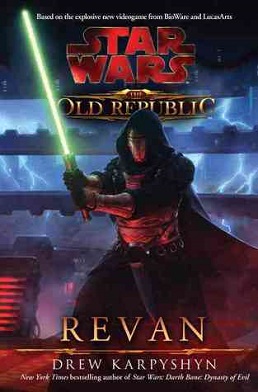
Star Wars: The Old Republic: Revan is part of the Star Wars expanded universe. Written by Drew Karpyshyn and released on November 15, 2011, Revan fills in the gaps between the RPG games Star Wars: Knights of the Old Republic and Star Wars: Knights of the Old Republic II - The Sith Lords, as well as providing a backstory for events in the MMORPG Star Wars: The Old Republic.
The Sith Lords Restored Content Modification (TSLRCM) is a fan volunteer effort to reinstate or recreate unused content for the 2004 video game Star Wars Knights of the Old Republic II: The Sith Lords and fix a vast number of technical issues present in the retail release of the game. A years-spanning project that aims to improve the gameplay experience of The Sith Lords as intended by its developer, TSLRCM is developed by a group of fans who pieced together disparate narrative elements through data extracted from the game's fragmented code, which contained innumerable unused original assets and voice-over recordings, and incorporated these alterations into the final product. The mod's first public release was in September 2009. As of 2015, the mod is endorsed and supported by Aspyr Media, Inc., an American video game developer and publisher responsible for the continued support of The Sith Lords on modern platforms.


